
The great black hawk is a bird of prey in the family Accipitridae, which also includes the eagles, hawks, and Old World vultures.
The mangrove black hawk, Buteogallus anthracinus subtilis, is a neotropical bird of prey in the family Accipitridae native to South and Central America. Briefly treated as a distinct species, Buteogallus subtilis, recent evidence strongly suggests it should be considered a subspecies of the common black hawk.

The Chaco eagle or crowned solitary eagle, is an endangered bird of prey from eastern and central South America. Typically it is known simply as the crowned eagle which leads to potential confusion with the African Stephanoaetus coronatus. Due to its rarity, not much is known about its biology or population.

The black-chested buzzard-eagle is a bird of prey of the hawk and eagle family (Accipitridae). It lives in open regions of South America. This species is also known as the black buzzard-eagle, grey buzzard-eagle or analogously with "eagle" or "eagle-buzzard" replacing "buzzard-eagle", or as the Chilean blue eagle. It is sometimes placed in the genus Buteo.
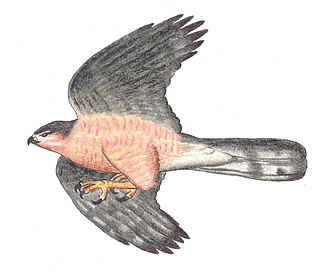
Gundlach's hawk is a species of bird of prey in the family Accipitridae. It is one of 21 endemic bird species of Cuba. The common name and Latin binomial commemorate the German-Cuban ornithologist Juan Cristobal Christoff Gundlach (1810–1896). It is threatened by habitat loss and human persecution.

The black-collared hawk is a species of bird of prey in the family Accipitridae. It is monotypic within the genus Busarellus. It has a widespread range of presence, from western Mexico to Uruguay. Its natural habitats are subtropical or tropical moist lowland forests, subtropical or tropical swamps, and swamps.

The rufous crab hawk or rufous crab-hawk, is a species of bird of prey in the family Accipitridae

The black-faced hawk is a species of bird of prey in the family Accipitridae. This low-density species has traditionally been believed to be restricted to Amazon Basin north of the Amazon River, but there are several records south of this river, in, for example, the Brazilian states of Pará and Acre, and southeastern Peru. It is closely related to the white-browed hawk and individuals showing a level of intermediacy between the two species are known, suggesting that they rarely hybridize

The mantled hawk is a South American species of bird of prey in the family Accipitridae.

The blue-winged racket-tail or Sulu racquet-tail is a species of parrot in the family Psittaculidae. It is endemic to Tawi-Tawi island in the Philippines and is one of the most endangered parrots in the world. It is threatened by habitat loss and the poaching for the cage-bird trade.
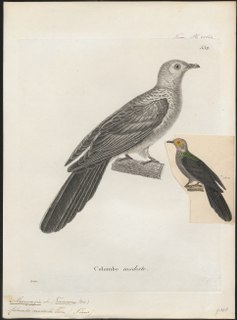
The black cuckoo-dove, also known as the slaty cuckoo-dove, is a species of bird in the family Columbidae. It is endemic to the Lesser Sunda Islands, being found on Timor, Wetar, Rote, and Atauro. It inhabits primary and secondary monsoon forest, eucalyptus forest, and woodlands. It is 38.5 cm (15.2 in) long on average and is mainly dark bluish-gray, lighter on the head and underparts and darker on the wings and tail. It has yellow orbital skin.

The golden-chested tanager is a species of bird in the family Thraupidae. It is found in Colombia and Ecuador. Its natural habitats are subtropical or tropical moist lowland forests and subtropical or tropical moist montane forests.
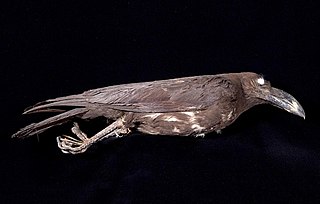
The brown-headed crow is a passerine bird of the genus Corvus in the family Corvidae. Endemic to Indonesia, it has a fragmented distribution in subtropical or tropical moist lowland forest and subtropical or tropical mangrove forest. It is threatened by habitat destruction and the IUCN has rated it as being "near-threatened".

The Cuban blackbird is a species of bird in the family Icteridae.

The Cuban oriole is a species of songbird in the family Icteridae. It is endemic to Cuba.
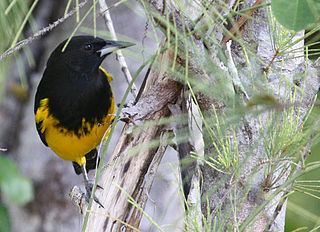
The Bahama oriole is a species of songbird in the New World blackbird family - Icteridae. It is endemic to the Bahamas. It is listed as endangered by the IUCN (CR). The taxon was originally classified as its own distinct species in 1890 by Joel Asaph Allen before it was lumped with the Cuban oriole, Hispaniolan oriole, and Puerto Rican oriole into a single species by the ornithologist James Bond in his book "Birds of the West Indies". It wasn't until 2010 that all four birds were again elevated to full species status based on a combination of evidence from DNA, plumage and song. Since it was not recognized as a distinct species for so long, the Bahama oriole's preferred non-breeding season habitat is unknown and current estimates of its exact numbers remain vague.

The Puerto Rican oriole is a species of bird in the family Icteridae, and genus Icterus or New World blackbirds. This species is a part of a subgroup of orioles that includes the North American orchard oriole, Icterus spurius, and the hooded oriole, Icterus cucullatus.
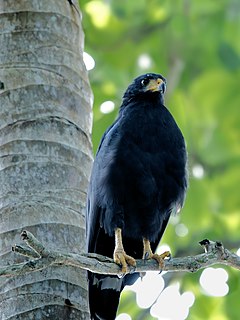
The common black hawk is a bird of prey in the family Accipitridae, which also includes the eagles, hawks, and Old World vultures.




















